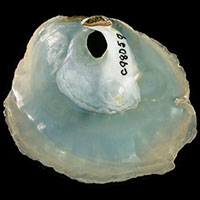|
< Previous family introduction |
|
|||||
 |
Family Anomiidae Jingle Shells
|
|||||
|
The Anomiidae is a numerically small family of about 25 species, of which three occur in NSW. They attach to the substrate by a byssus that protrudes through a hole in the lower valve, attaching to rocks, stones, shells or other solid substrates, including mangroves. The family occurs worldwide, mainly in warm waters. It includes the unusual Enigmonia aenigmatica which occurs in tropical Australia (but not NSW) living in the high intertidal zone on mangroves and solid substrates, where it is only temporarily attached and is capable of moving around. There are three species known from NSW, two of which also occur in New Zealand. The three species occupy different habitats in NSW. Anomia trigonopsis is abundant on sand and mud flats and on mangrove trunks in estuaries. Monia zelandica is less common and is found on exposed and partly exposed rocky shores such as in the outer reaches of Sydney Harbour. Monia deliciosa is even less common, and is known from 100-400 m. Family Reference Beu, A.G. 1967. Notes on Australasian Anomiidae (Mollusca, Bivalvia). Transactions of the Royal Society of New Zealand 9: 225-243. Coverage All the species known from NSW are detailed here. Identification Notes The shells of the Anomiidae are medium to large in size, reaching up to 85 mm in height. They are rounded to ovate in outline, flat or irregularly folded, reflecting the shape of the substrate to which they attach. They are light in weight and translucent when small, but thicker and heavier as they become larger. The lower valve is thinner than the upper valve and has a hole through which the byssus protrudes to attach the shell to the substrate.
|